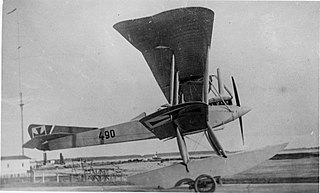Related Research Articles
Luftverkehrsgesellschaft m.b.H. was a German aircraft manufacturer based in Berlin-Johannisthal, which began constructing aircraft in 1912, building Farman-type aircraft. The company constructed many reconnaissance and light bomber biplanes during World War I.

The Maybach Mb IVa was a water-cooled aircraft and airship straight-six engine developed in Germany during World War I by Maybach-Motorenbau GmbH, a subsidiary of Zeppelin. It was one of the world's first series-produced engines designed specifically for high-altitude use. It was quite different engine design than the previous Maybach Mb.IV, not just a simple modification.

The Lübeck-Travemünde F.2 was a 1910s German reconnaissance floatplane. The F.2 was an improved version of the company's earlier F.1 floatplane and was the first armed aircraft built by Flugzeugwerft Lübeck-Travemünde GmbH, a subsidiary of Deutsche Flugzeug-Werke. The F.2 was a twin-float biplane powered by a 220 hp (164 kW) Mercedes D.IV engine. With a crew of two, the observer's rear cockpit was fitted with a 7.92 mm (0.31 in) Parabellum machine gun. Eleven aircraft were built.

Imperial German Navy seaplanes numbers 1105 and 1106 were the only examples of a unique design produced for the navy's flying service during the First World War. They were unarmed biplanes of conventional configuration with staggered wings of unequal span. The empennage included a sizable ventral fin. Intended as training aircraft, the pilot and instructor sat in tandem, open cockpits. The undercarriage consisted of twin pontoons. The interplane strut arrangement was remarkable for its day, consisting of N-struts and V-struts without any rigging wires.
Number 1650 was the sole example of a unique seaplane design produced for the flying service of the Imperial German Navy during the First World War. From 1916 onwards, the Kaiserliche Werften produced a range of training seaplanes for the Navy, in order to free the nation's major seaplane manufacturers to produce front-line types. During the closing stages of the war, however, the Kaiserliche Werft Danzig and Kaiserliche Werft Wilhelmshaven produced a small number of front-line types as well, including this machine. Number 1650 was an armed reconnaissance seaplane equipped with radio equipment capable of transmission and reception, therefore gaining the naval CHFT classification.

Imperian German Navy seaplanes numbers 401 to 403 were the only three examples of a unique seaplane design produced for the Navy's flying service during the First World War. Production of these types commenced in April 1915 in an effort to supply the navy with a seaplane trainer of contemporary design. With the outbreak of war, the output of Germany's major seaplane manufacturers was taken up with producing front-line types, and the only trainers available were obsolete or rebuilt machines withdrawn from their original duties. Number 401 and its two siblings were delivered to the Navy in August 1915.

Imperial German Navy seaplanes 461 and 462 were the only two examples of a seaplane design produced for the Navy's flying service during the First World War. Number 461 was built in October 1916 and Number 462 in September 1917 as the German seaplane bases searched for purpose-built training aircraft to supplement their collection of retired combat types.

Imperial German Navy seaplane Number 945 was the sole example of a unique seaplane design produced during the First World War. Throughout the war, the Kaiserliche Werft Wilhelmshaven had been producing small numbers of training seaplanes for the German Navy, but as the conflict continued, they built a small number of armed types as well, including Number 945. While the general layout of this aircraft was conventional enough for its day, it included a number of unusual features. The single-bay wings were braced with single, large I-struts, and the vertical stabiliser was virtually non-existent, consisting of little more than a stub on the dorsal side of the rear fuselage. The rudder was hinged to the end of the fuselage and hung down below it. The Navy classified it as a C3MG type; indicating armament with both fixed and trainable machine guns.

The Kaiserliche Werft Wilhelmshaven 947 was a maritime reconnaissance floatplane built for the Imperial German Navy's Naval Air Service during the First World War, the sole example of its type. It was one of only three armed aircraft built by the Kaiserliche Werft Wilhelmshaven amongst a variety of trainer seaplanes that they had produced for the Navy during the course of the war. Number 947 was a two-bay biplane of conventional design, with twin pontoon undercarriage, and two open cockpits in tandem. It received the Naval classification CHFT, indicating an armed aircraft equipped with radio gear capable of both sending and receiving.

The Sablatnig N.I was a bomber aircraft developed in Germany during the First World War, a development of the Sablatnig C.I adapted for night operations.

The Sablatnig P.III was an airliner produced in Germany in the early 1920s.

The Sablatnig SF-1 was a reconnaissance seaplane built in Germany during the First World War.
The Sablatnig SF-2 was a reconnaissance seaplane produced in Germany during the First World War.
The Sablatnig SF-5 was a reconnaissance seaplane produced in Germany during the First World War.

The Sablatnig SF-8 was a training seaplane produced in Germany during the First World War. While Sablatnig's previous designs for the Imperial German Navy had often seen service as trainers, the SF-8 was purpose-built for this role, at Dr Sablatnig's suggestion. The SF-8 was similar to the firm's earlier designs: a conventional two-bay biplane with staggered wings of unequal span, with open cockpits in tandem.

The Sablatnig C.I was a conventional C-type reconnaissance two-seater aircraft developed and built by Sablatnig in Berlin, Germany in 1917. It was a two-bay biplane of conventional design, with staggered wings, two open cockpits in tandem, and fixed, tailskid undercarriage.

The Sablatnig C.II was a conventional C-type reconnaissance two-seater aircraft developed and built by Sablatnig in Berlin, Germany in 1918.

The Sablatnig C.III was a monoplane C-type reconnaissance two-seater aircraft developed and built by Sablatnig in Berlin, Germany, in 1918.